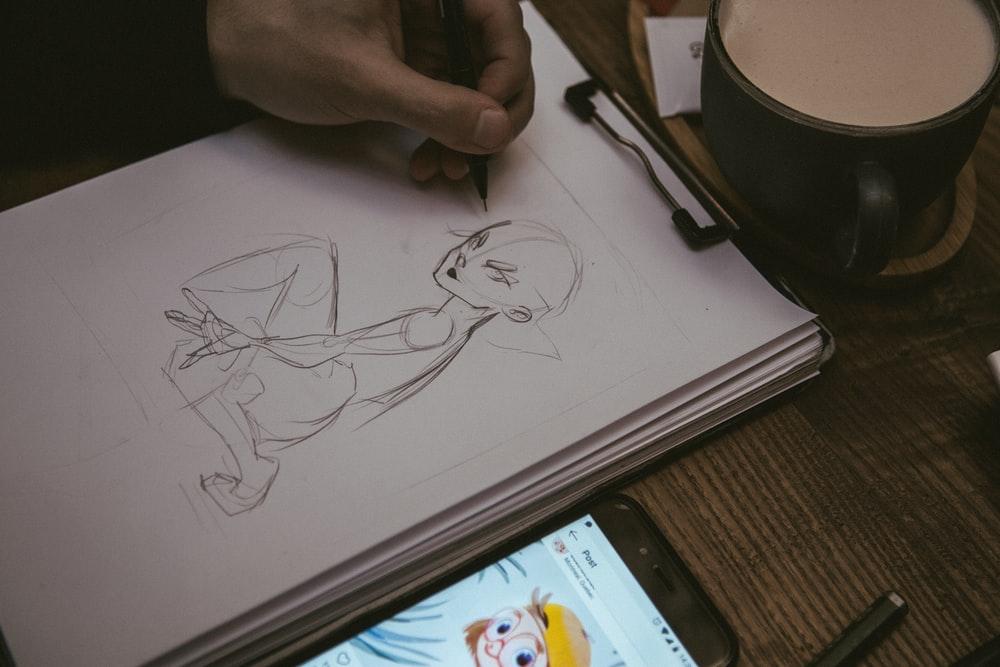Are you struggling to get your comics done on time? Some artists, even the most dedicated and hard-working ones, find it challenging to work to a deadline. This is a common problem among the most skillful artists because their comics tend to overflow with meticulous detail.
If you recognize yourself in the description above, or if you want to learn to draw comics faster for any other reason, this article is for you. It will help you speed up your drawing process using seven expert dos and don’ts collected from professional artists.
The tips are listed in no particular order, so please scroll through and focus on those that you find the most helpful in your specific situation. Let’s begin!
Don’t Skip the Early Sketch
Let’s get an important thing out of the way and tell you that you should not, under any circumstances, skip the early sketch.
All artists use the same basic principles to draw comics. We start with the most basic, boldest shapes, refining them into progressively smaller, more detailed drawings until we get the desired result.
These initial shapes have a two-fold purpose:
- Allowing you to set proportions accurately at the early stage
- Serving as the foundation to build upon
Skipping this step is not a good way to increase your drawing speed. This is arguably the most crucial part of the entire process, as getting the proportions wrong is the last thing you want to do. No matter how great the details are, if your drawing’s proportions are off, there’s no saving it.
Draw from Life
Regardless of whether your comics depict superheroes, cartoonish characters, or environments, it is vital to learn to sketch from life. This is particularly true for moving objects. It forces you to capture fleeting moments quickly and trains your mind to filter out the unnecessary details and focus on the critical stuff.
When doing this, try to get as much information about the image in front of you down on paper in as little time as possible. This means going outside (or looking out the window at the very least) and drawing passing cars or the people walking by.
By the way, before you start drawing people, it would be a good idea to learn how to draw a human face well.
Sitting at your kitchen table or in your studio trying to speed draw can only get you so far. The distractions and unpredictable circumstances of a live scene will force you into making faster decisions and train your mind and muscles to draw faster.
Don’t Correct Every Mistake
One of the keys to drawing comics at speed is to draw several lines lightly and choose which one to define. This means embracing your mistakes and using them to filter out the best parts of your work. Your sketches will benefit from this, as the reader will be able to see the scene’s movement, life, and drama through the drawing process.
Even the most boring scenes can be brought to life with a fluid and vibrant use of lines. So, instead of getting in the way, your mistakes emphasize your drawing’s beauty, adding character to what could otherwise be a bland, clinical depiction.
Use High Contrast and Tonal Blocks
You can use basic shading to block the simplest shapes further. Do yourself a favor and use solid shadows and high contrast. This makes the forms easier to discern and speeds up the drawing process immensely.
Once you’ve shaded your outline into tonal blocks, it is time to gently lift out the lighter areas. Painters do this all the time, relying on the ugly underpainting as a base to build on using color and tone. You can do a similar thing with your comics, adjusting the tone of specific areas with your eraser.
Think of it like this — lifting out tone is much quicker than drawing it in. This will make it more challenging to draw photorealistic comics, but that’s probably not what you’re going for in your comics anyway. Instead, you’re likely looking to add more atmosphere in less time, precisely what this technique allows.
Draw from the Elbow
Your ability to draw quickly depends very much on your drawing technique — go figure! Drawing from the wrist will slow you down, as it forces you to draw with more care and more precisely. That is perfectly fine, even necessary, in the final detailing stage, but not what you want when sketching a quick outline.
Try to draw from the elbow to increase speed. Set your paper upright at an easel or at an angle on the desk, allowing you to step back and look at the perspective. This elbow-based, loose-arm technique will enable you to draw comics with a more dynamic movement, producing quicker results on a large scale.
The lines will flow across the page as your broad movements enable you to ignore the details and get the preliminary sketch done in half the time.
Don’t Be a Perfectionist
Do you tend to draw the same rough sketch repeatedly until it is at the perfect amount of roughness and sketchiness? Do you look at each line in your drawing with a discerning eye? You might want to sit down because we have some bad news — you’re a perfectionist.
Don’t worry; the condition is treatable. All you need to do is resist the temptation to add more details. Remember — the perfect is the enemy of the good. So, stop digging yourself into a hole, and finish what you started.
The uncomfortable truth is that 90% of your “perfect” drawings will not be discernably better than the “good” ones. So, we recommend against doubling your time and effort to achieve something most readers will never notice.
Trace Your Previous Work
Tracing is a great way to speed up your drawing process, as sacrilegious as it may sound. This is particularly true when it comes to drawing the same character or scene again and again within a comic.
Even the purists will find it hard to argue against the fact that tracing dramatically increases drawing speed. However, there is a downside. Tracing can lead to stilted, clumsy, and crude drawings and does not have much artistic merit. So, you should only use it for preliminary “scaffolding” and apply the detail to each scene separately.
Using tracing in this way, you could even rely on other artists’ work without crossing any ethical boundaries. It takes an accomplished artist to bring a traced image back to life with their details and shading. Constructing a sense of motion over a traced image is not easy — give it a shot and see for yourself.
Closing Thoughts
Learning how to draw faster may sound like a ridiculous notion to the uninitiated. After all, if you already know how to draw, what could be so difficult about doing it a bit faster? However, anyone who has ever done some serious drawing or painting knows that this is easier said than done.
Once you settle into a style, it isn’t easy to get out of it. You want your work to succeed, so you stick to your comfort zone and play it safe. Trying out new ideas, techniques, and methods can be very scary, and that fear of failure slows us down.
In reality, we have nothing to fear because there is no success without failure. If you can alter your expectations, open your mind, and step out of your comfort zone, you can only benefit in the long run.












